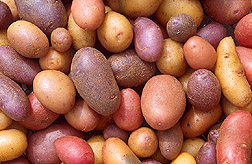This page has been archived and is being provided for reference purposes only. The page is no longer being updated, and therefore, links on the page may be invalid.
Read the magazine story to find out more. |
|
|
New Methods Developed to Detect, Measure Potato Phytonutrients
By Jan SuszkiwMay 19, 2010
Potatoes come in all shapes, sizes and colors-including tubers with red, yellow, orange and purple flesh. This diversity also applies to phytonutrients, Agricultural Research Service (ARS) scientists in Prosser, Wash., are discovering.
Together with colleagues, they've devised new analytical procedures for rapidly detecting and measuring phytonutrient concentrations in the tubers. Phytonutrients are plant compounds that are of particular interest for their potential to help diminish the risk of cardiovascular disease, respiratory problems and certain cancers, note Roy Navarre and Chuck Brown, geneticists with the ARS Vegetable and Forage Crop Research Unit in Prosser.
Using the new analytic methods, Navarre and Brown profiled the phytonutrient contents of several hundred lines of wild and cultivated potato. For example, their analysis of phytonutrients known as phenolics showed concentrations that ranged from 100 to more than 1,500 milligrams per 100 grams dry weight in the potatoes.
One type of phenolic, called chlorogenic acid, is being tested by university cooperators for its potential to lower blood pressure. Also of interest are potatoes with high antioxidant activity, which is credited with helping neutralize cell-damaging molecules in the body called free radicals. Some potatoes boast antioxidant levels that rival vegetables such as spinach, Navarre reports.
Read more about the phytonutrient studies, as well as other potato research being conducted by ARS scientists at other locations, in the May/June 2010 issue of Agricultural Research magazine.
ARS is the principal intramural scientific research agency of the U.S. Department of Agriculture (USDA). The research also supports the USDA priority of improving nutrition and health.

